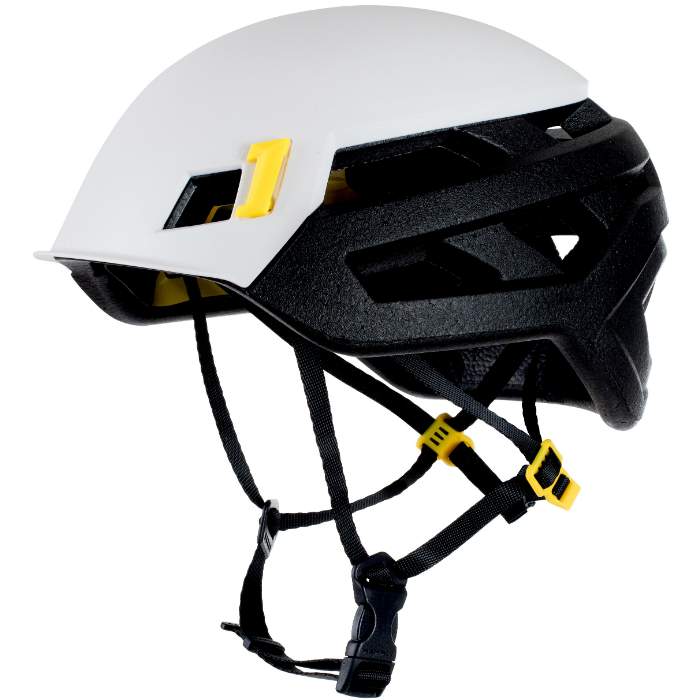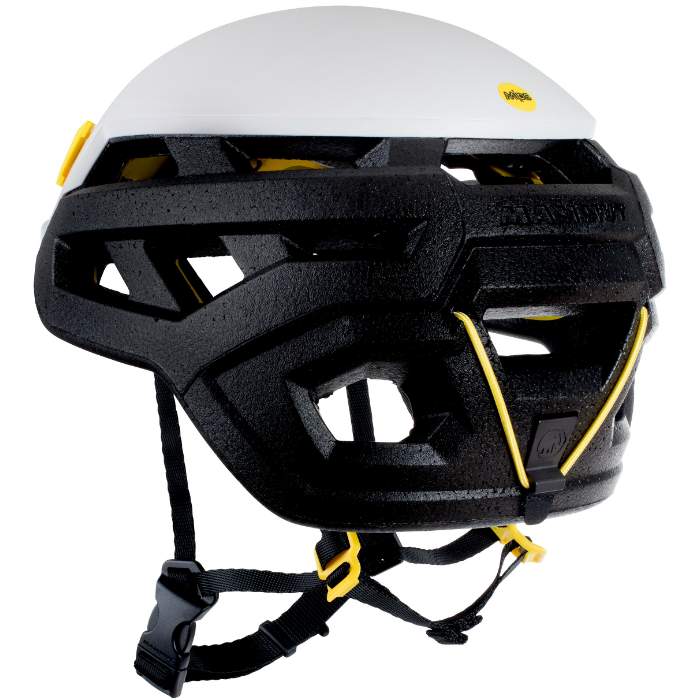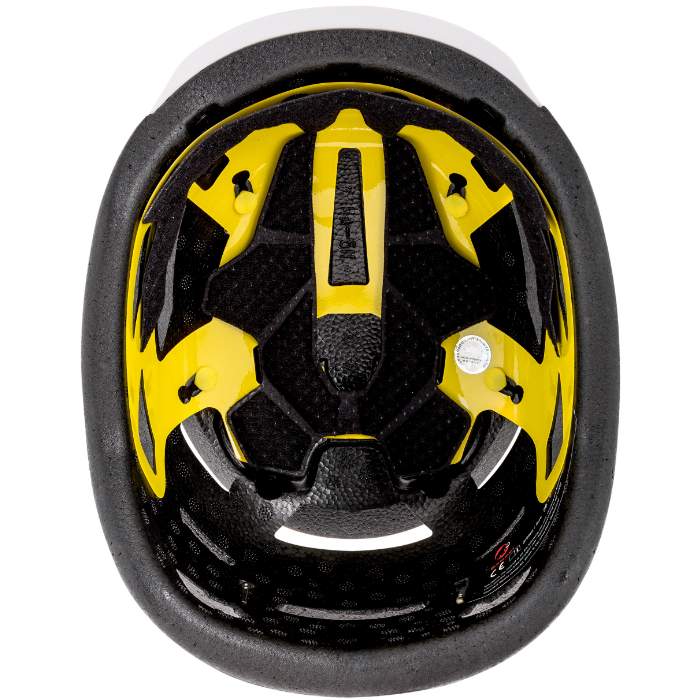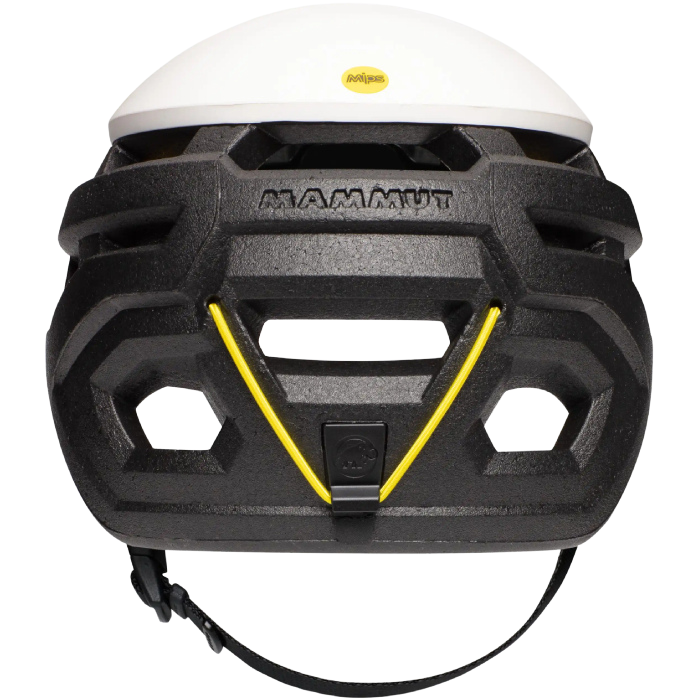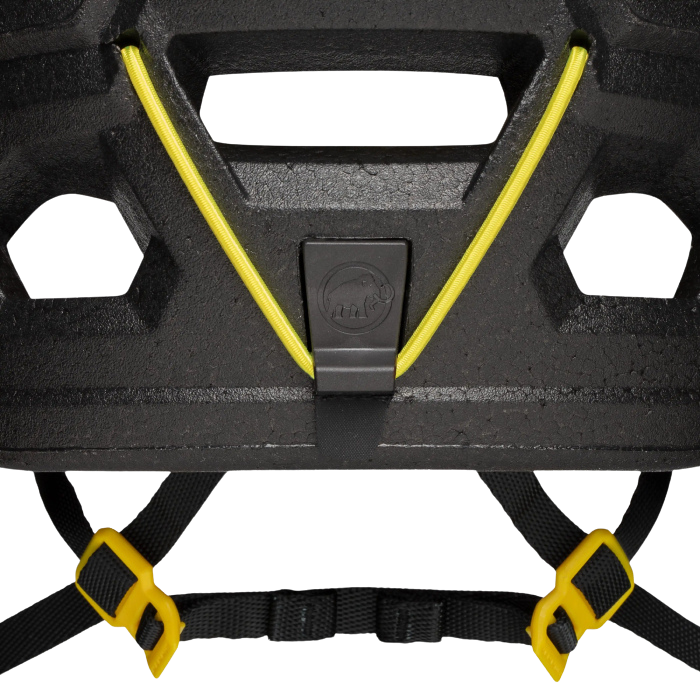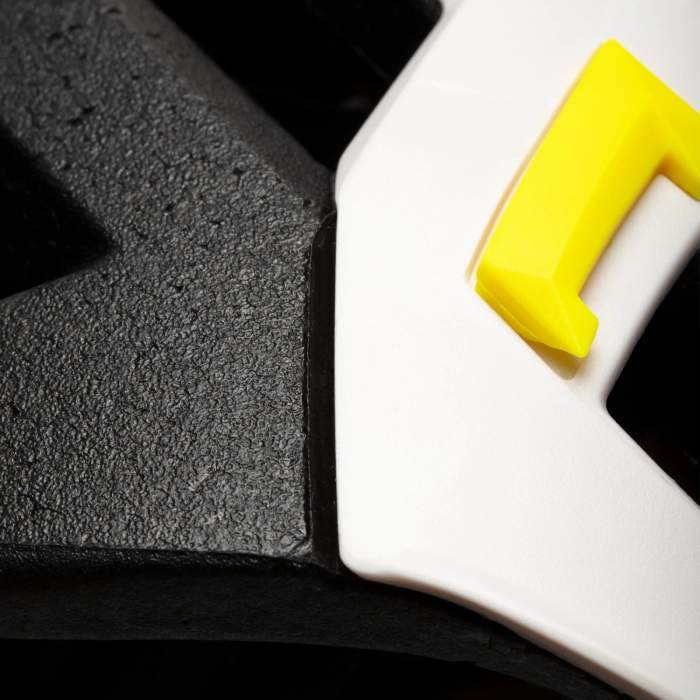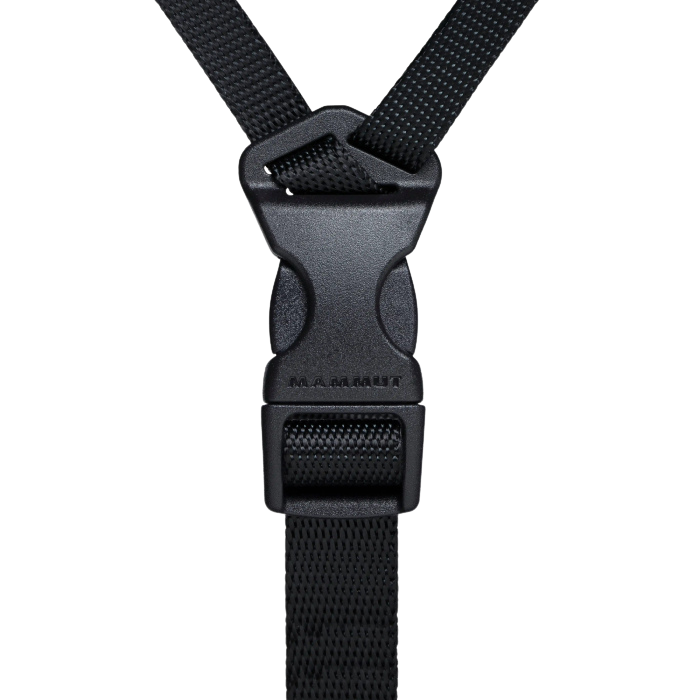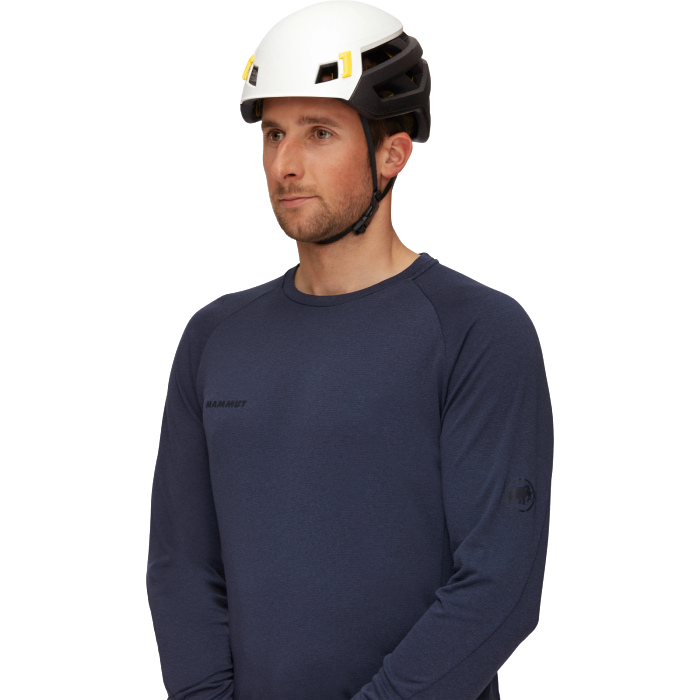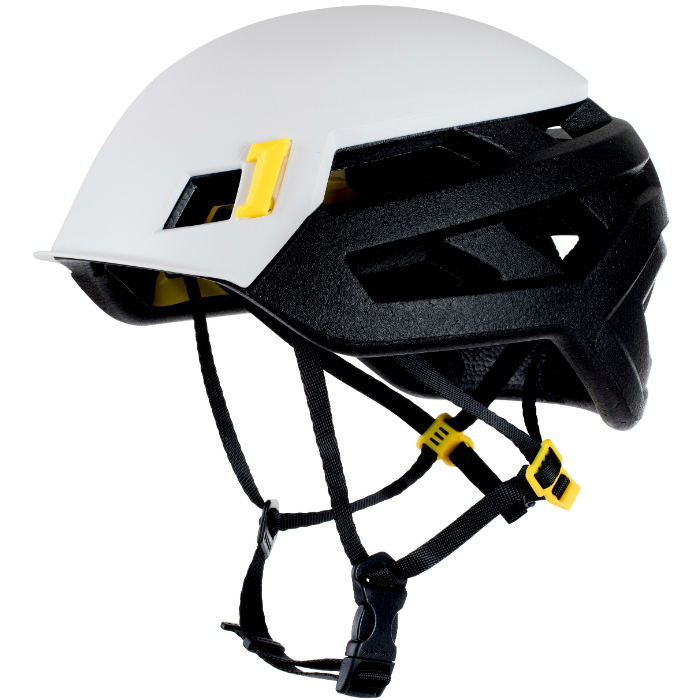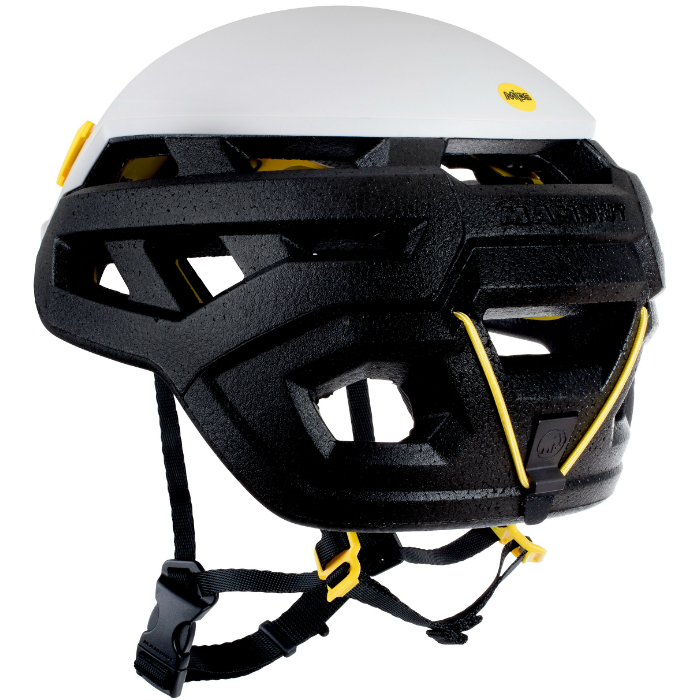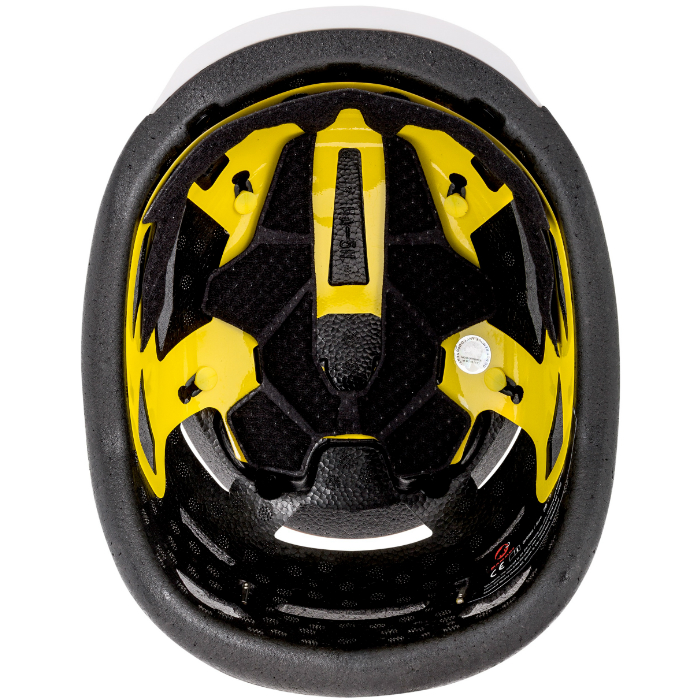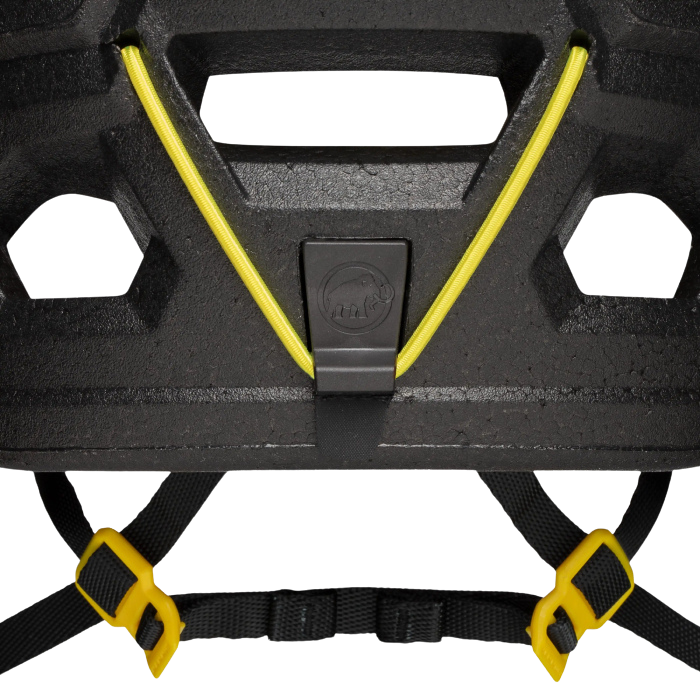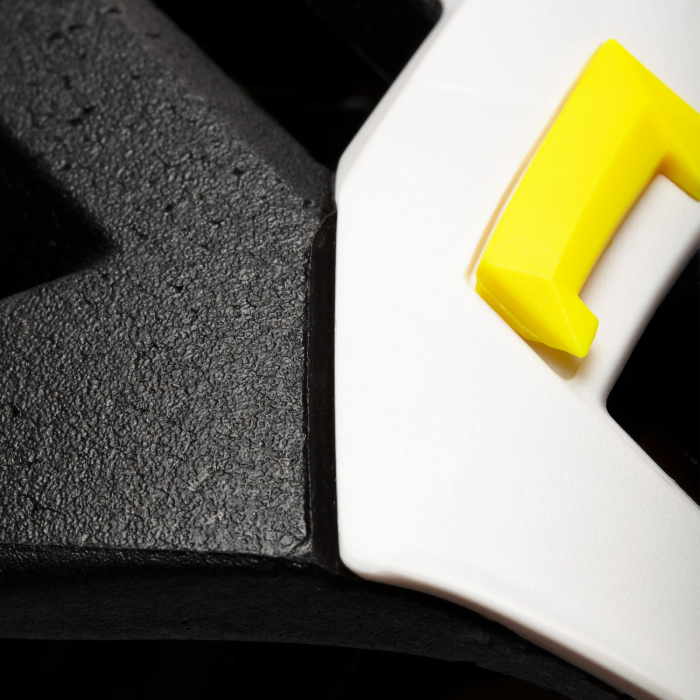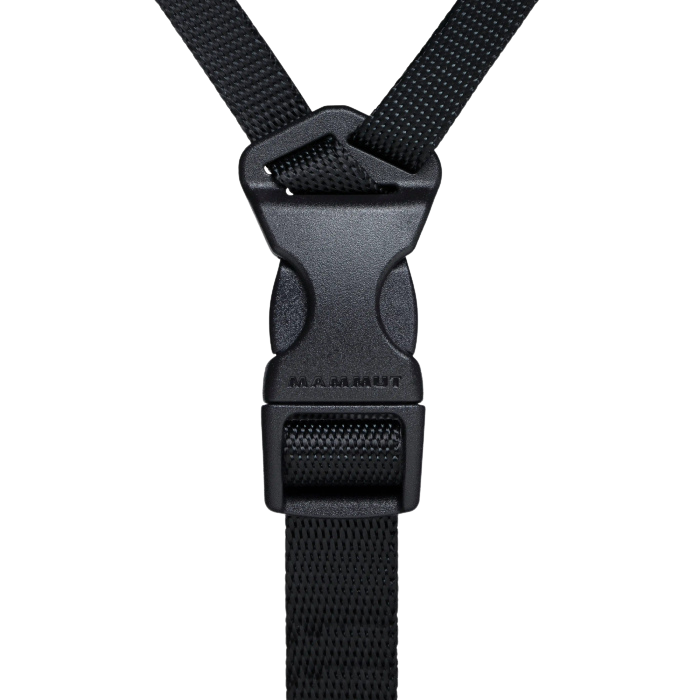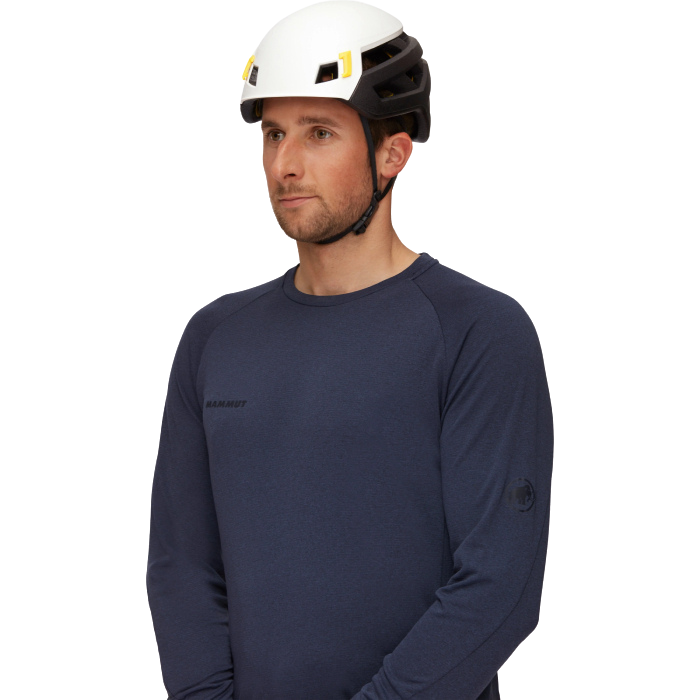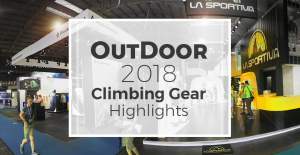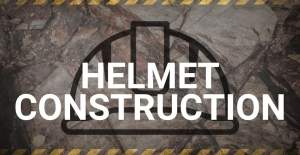A pictoral representation of the UIAA-106 and EN-12492 standards for helmets.
Wall Rider MIPS
Description
A pioneer among its peers: the first climbing helmet featuring the patented MIPS technology, the Wall Rider MIPS offers maximum safety and protection from impacts caused by tumbling rocks or falls. When the Wall Rider MIPS helmet is subjected to an angled impact, the low friction layer allows the helmet to slide relative to the head. This means that some portion of the rotational forces and energies acting on the head at impact are redirected and absorbed thanks to the large low-friction layer, rather than being transferred to the brain, this reduces the risk of a brain injury. The Wall Rider MIPS combines a cushioning EPP (Expanded Polypropylene) core with a partial hard shell for maximum safety. At just 225 g, this makes the helmet a real lightweight. The Wall Rider feels very comfortable to wear thanks to its ergonomic fit and pleasant cushioning. Safety on the mountain with the Wall Rider MIPS.
MIPS technology - the new securityThe first climbing helmet with the patented MIPS technology: The Wall Rider MIPS offers maximum safety and reliably protects against stone impacts or falls. In the event of a side impact, the helmet shifts through the low-friction MIPS layer and transmits the force exerted on your head. This considerably reduces the risk of brain injuries.
Ergonomic fit for more wearing comfort and safety - When the helmet sits, it automatically means more safety. That's why the Wall Rider MIPS convinces with an ergonomic fit that adapts perfectly to your head and provides a high degree of comfort. This is complemented by the comfortable padding and the large ventilation zones, ensuring outstanding air circulation and even heat dissipation.
FEATURES
- EPP core combined with a partial Hard Shell
- Ergonomic interior with comfortable padding
- Large ventilation openings for good air circulation and heat discharge
- Ultra-lightweight, minimalist adjustment system
- All-round, fully adjustable chin strap for optimum fit
- 2 clips on front and rubber loop on back for fixing a headlamp
Retail price
When you click a link below and then checkout online, no matter what you buy (climbing gear or not), we get a small commission that helps us keep this site up-to-date. Thanks!


Weight (g)  Weight (g)In grams, the weight, as stated by the manufacturer/brand. If there are differences in weight (due to multiple size or optional accessories) we note those here. | 225 g Size 1: 225 g / 7.9 oz |
Gender  GenderThis is the gender as stated by the manufacturer/brand. We use the term "Men" and "Unisex" interchangeably, as there is no difference between these types of helmets. |
Unisex |
Size Range  Size RangeThe sizing options of the helmet according to the manufacturer. | 20.00 in - 24.00 in Size 1: 52-57 cm / 20-22 in |
Features  FeaturesBike Cert (EN 1078)The EN certification for helmets used for bicycling and skating. The major difference in testing 1078 involves needs for more head coverage and for the helmet to pass a deflection or 'roll-off' test of the impact force. BrimHaving a brim on a helmet may be inconsequential to some climbers but they make a great additional bit of protection against sun, rain and falling debris like small rocks or verglass. Multiple SizesThis is helpful for those with particularly small or large heads because helmets that come in 2 or 3 sizes cover a broader range of head size. Usually these are denoted as size 1 or 2, though some brands have S/M and M/L. Face Shield CompatibleFace shields are a part of PPE that could be handy when drilling, developing and cleaning particularly dirty remote routes. Usually only used by work at height professionals. MIPS technologyMIPS or Multidirectional Impact Protection System is a technology designed to reduce the amount of impact force that makes it to the brain. This is accomplished by adding a low friction cap between the liner and the helmet, allowing the shell to deflect around the head rather than transfer the forces from impact directly to the wearer. Many bicycle helmets include this feature and it is starting to be applied to sports like skiing, motorcycling and climbing. Many MIPS helmets are also EN1078 compliant. Ponytail CutoutSo far these are only found in "women's" helmets. It's a cutout / notch area that accommodates a low hanging ponytail hairstyle. RECCO® reflectorThese are used in locating someone missing or buried in an avalanche and are becoming more common in climbing gear due to the increased popularity of ski mountaineering. Though they are more often sold as something to add onto the helmet than being built into one, some manufacturers have begun to build them in. Ski Cert (EN 1077)The EN certification for helmets used for climbing and skiing. This test is simpler than the EN/UIAA one performed for helmets in general, but increases the amount of force that a helmet must endure. Likely this to simulate the faster speeds involved with downhill skiing impacts versus rockfall or climber accidents. This cert becoming more common in helmets as SkiMo popularity increases and more climbers are adding backcountry skiing to their mountaineering repertoire. |
Brim Multiple Sizes MIPS technology |
Quick Adjust  Quick AdjustQuick Adjust refers to the straps of the helmet. Do you want the ability to ability to "quickly" adjust the fit. This could be a dial, or other plastic pieces. Really, most climbers don't need to change the fit of the helmet often, unless you're climbing with and without hats, or you have big hair that flattens and then requires tightening after climbing for awhile. |
No |
Vents  VentsRefers to openings in the helmet body to allow air flow. Commonly found in most helmets these days, but often more so in foam and hybrid foam helmets than traditional hardshell polycarbonate shells. Learn More
Click here to read more on helmet construction |
Yes |
Headlamp Compatable  Headlamp CompatibleMany helmets include hooks or clips for holding a standard headlamp in place, which is quite useful for the caver or alpinist. Ask any climber who has been benighted and they’ll tell you just how useful this feature can be. |
Yes |
Face Shield Compatable  Face Shield CompatibleFace shields are a part of PPE that could be handy when drilling, developing and cleaning particularly dirty remote routes. This feature isn't very common in climbing helmets and usually only used by work at height professionals. |
No |
| Certification | EN |
No reviews yet.
So, the Mammut Wall Rider MIPS helmet is a worthwhile investment, it has all the features you will need for climbing and mountaineering. It comes in a lightweight and compact package and the latest MIPS technology means that you will be as safe as you can be. If you are going to wear a climbing helmet you have decided that the risk of head injury is worth the money. You may as well have the best technology that is currently offered and that is currently MIPS. Be very careful as there are fakes and cheap helmets available that do not conform to MIPS standards so check carefully and only buy a helmet from a reputable manufacturer.
The only real downside to the MIPS version of the Wall Rider is the weight. It’s a bit heavier than the regular version of the Wall Rider, 260g instead of 220g, and heavier than the Petzl Sirroco (185g) or the Edelrid Salathe (215g). However, the extra protection offered by the MIPS makes it quite a versatile helmet that works well rock climbing, alpine climbing and even ski touring (though it’s not specifically rated for it in part due to the large vents holes that are not allowed on ski helmets).
The Mammut Wall Rider MIPS wins our Top Pick award because it's the first climbing helmet to incorporate the potentially brain protecting MIPS technology. We expect to see many more companies follow suit soon to offer this technology as well. While it costs more than any other climbing helmet we have tested, we think its potential to prevent a potentially disastrous injury is worth the small bump in cost, and highly recommend you give this helmet a shot.
The EPP is what helps to keep this helmet down to the book values of 225grams , my version weighs 260 and is the 56 – 61 cm size. The “skull cap” part of the Wall Rider is what gives the helmet the initial impact protection. It we’ll fend off light debris and knocks without concern. Most of what mine has had to contend with is the ice and debris being thrown down from my lead or other teams. Along with a couple of cracks off a wall when I misjudge the angle of the route.
The UIAA equipment standard provides a baseline for equipment performance in a test lab under controlled conditions on new equipment. Although these test conditions are relevant to the conditions encountered climbing, conditions encountered at the crags and the condition of the equipment are equally important. This recommendation from the UIAA member federation The British Mountaineering Council (BMC) provides vital equipment information that is NOT explicitly addressed in the standard, particularly failure modes of the equipment and recommendations for the use, inspection, maintenance, and retirement of equipment.

